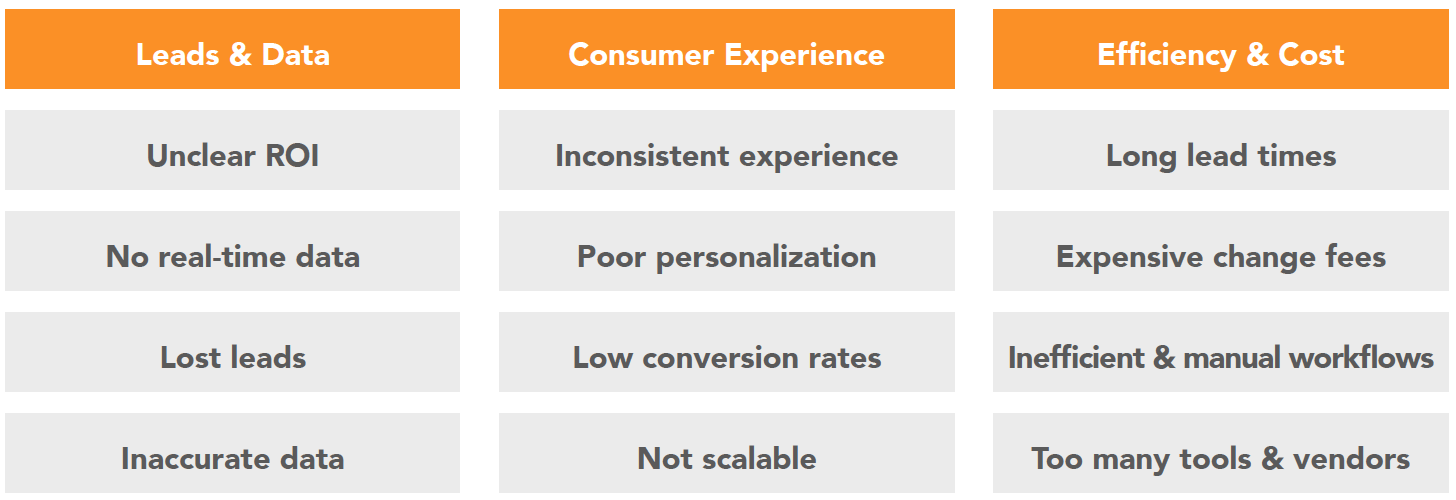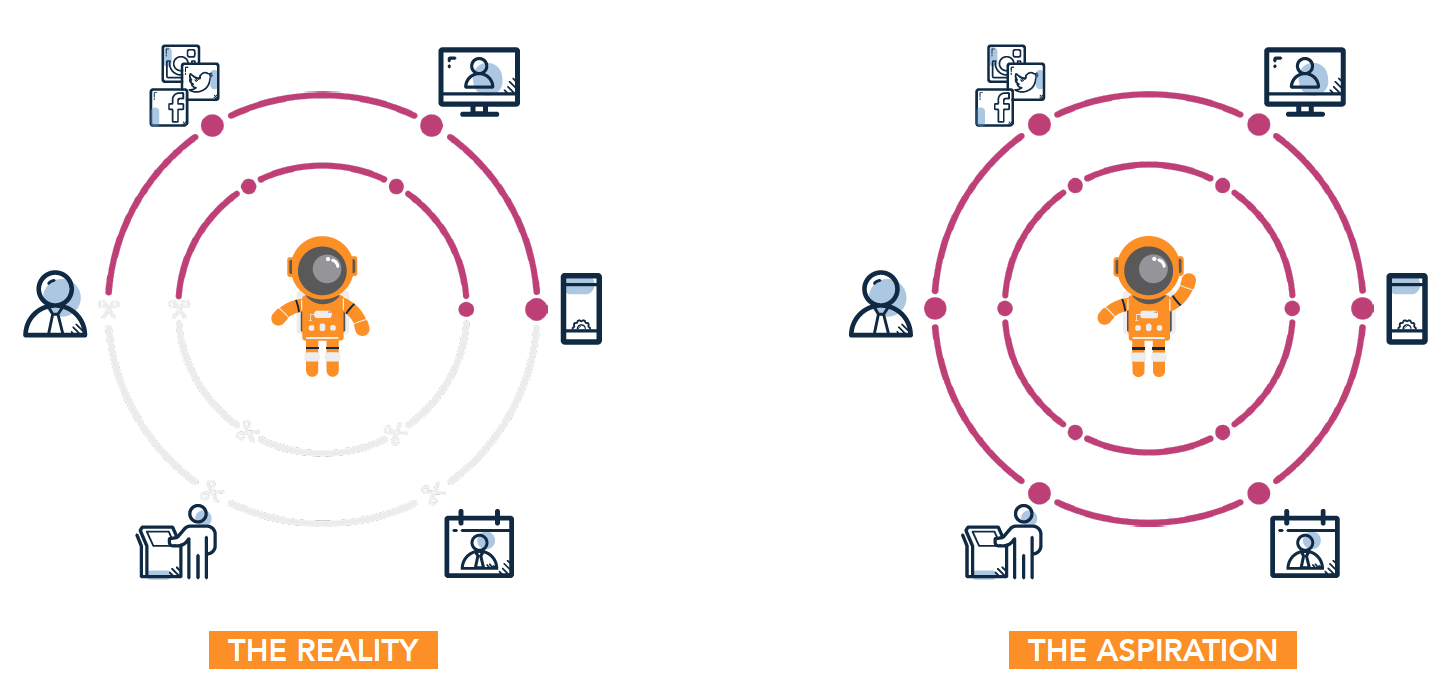Experiential Marketing: Top Challenges And How To Overcome Them [Executive Research]
.png?width=50&name=download%20(1).png) By
Julia Manoukian
·
6 minute read
By
Julia Manoukian
·
6 minute read
Disconnected, hard to run, measure, and scale. These probably aren’t the words that come to mind when you think of experiential marketing, but unfortunately, it’s the reality many brands are facing with the channel today. Even with the pandemic affecting the industry and events focussing on higher quality leads more than ever before, proving what is and isn’t working is going to be the lifeline for experiential in the year to come.
Let’s backtrack a bit.
Experiential marketing has been on fire for the past few years. Though things slowed down significantly in 2020 due to Covid-19, brands and consumers alike have learned to adjust to the new normal. With heightened consumer expectations, social and digital more challenging than ever before, and people flat out ignoring interruptive advertising, brands are still leaning on experiential marketing as a way to restore trust and authenticity in their brand experience.
But unlike these other channels, which have each been refined into a data-driven science, experiential is still the wild west of marketing—there is no standardized way to measure ROI because the scope, metrics, and goals of every activation vary so widely. As a result, experiential marketing has fallen behind the rest of the 360-degree marketing suite.
How can we catch up, both as an industry and as marketers?
Experiential Marketing: What's Going Wrong?
As it currently stands, experiential marketing is the fastest way to take consumers from awareness to purchase and advocacy. It's traditional marketing on steroids. But even though experiential is quickly becoming a major part of today's marketing mix, companies are still facing many challenges. Toss in the importance of safety protocols and pivoting for Covid and experiential marketers have a very difficult job on their hands.
According to a report by Adobe and Econsultancy,only 6% of marketers say they are "extremely confident" in their organization's ability to measure the return on investment for offline marketing programs. Clearly, when it comes to offline marketing (experiential, events, and other live activations), there's room for improvement.
What one marketing leader at an industry-leading automotive brand said to Limelight:
“The consumer experience isn’t great when we’re having a hard time checking people in, when people have to wait in long queues to get into an event… Imagine you went to an auto show, you get yourself into a car and you think: ‘Man, I love this car, I wanna go buy one’. And then two weeks later we send you a ‘Thank You’ email with an offer to take $1500 off your car. Not a great experience, especially when you’re a premium brand!”
If you’re like the dozens of companies that we researched within experiential, including BMW, Allstate, and TD, you likely feel pain in these areas:

Let's explore what these issues look like on a practical level.
Lack of real-time, actionable data
Despite a greater investment in experiential, many marketers have limited visibility, often because they don’t have access to real-time actionable data, or current data is inaccurate. A brand may know who attends what, but less on where they came from, if they want to be contacted by a sales representative or dealer, if they want a quote on a product or if they’re just looking around.
This lack of data and visibility makes proving a clear ROI a challenge. Marketing leaders also report problems around data accuracy, lost data and leads, as well as critical security gaps when managing consumer information.
"Experiential agencies are often obsessed with anecdotal consumer feedback, time-lapse films showing the ‘event in action,’ surveys reporting that 99% of attendees said ‘it was great, we loved taking part.’ All these elements can be important to a rounded piece of evaluation, but are really not a clear indication of the attitudinal shift, the change in consumer behavior or the incremental profit generated from the experiential campaign."
- Sarah Priestman, President, Sense, New York via Adweek
So what?
Without the ability to prove ROI, your team could lose budget to digital or other teams. For most experiential marketing departments, this has already happened with companies moving marketing budgets to more safe avenues. Retaining and eventually regaining budget is crucial for ongoing success.
For example, Audi, BMW, Mazda, Volvo, and Mercedes Benz have pulled out of certain auto shows because of an inability to prove a clear value and ROI even before the pandemic came into play.
Inefficient and manual operations
The numerous factors involved with experiential marketing—e.g., microsites, email, digital kiosks, and data integrations—have traditionally required different solutions or partners, making it hard for marketers to reduce friction along the consumer journey in a cost-effective and operationally efficient way.
Many brands still rely on manual processes such as using a paper and pen or spreadsheets, which creates long lead times (up to weeks) and hampers their ability send timely and personalized communications and improve conversion rates.
“The time to get the data off iPads and to get that data into our marketing platform for reporting, to make it actionable for anything else requires a lag of weeks. It takes a long time to stand up for experiential solutions, it takes a long time to get the data off these same solutions and back into the platform that needs it."
- Leader in large automotive organization via interviews with Limelight
So what?
In the short term, you're spending inefficiently. Paying one price for a registration or ticketing vendor, another for a custom app builder, another for a mobile photo booth—it adds up. And, many agencies charge extra for last minute updates and data collection and analysis.
Poor consumer experience
These paint points ultimately affect the ability for brands to deliver consistent consumer experiences. Poor personalization and delays are listed as two of the biggest symptoms consumers experience. Especially for a premium brand, how you treat consumers at every touchpoint can either make or break you. These factors ultimately impact conversion rates at each point of the journey and make it hard to prove and scale experiential programs.
“This might sound familiar to you. I’m currently in the market for a new car. While I’m considering a newer model of the brand I own, most of the marketing communications I receive don’t recognize me as a potential loyal customer. Furthermore, I recently visited the dealership, spent two hours there, and after returning home, received an email from the general manager of that same dealership inviting me to come in and check out the latest models. I was just there.”
- Google, Adam Stewart, Google’s VP of consumer goods via Think with Google
So what?
In the long term, you lose customers, and your brand suffers. Not delivering a seamless omni-channel experience will put companies at risk of missing out on $263 billion of value in revenue in efficiency savings over the next decade.

Why Is Experiential Harder To Run Than Other Channels?
Why is experiential harder to run and manage than other marketing channels? Other than the Covid related concerns which will pass in the foreseeable future, we researched and analyzed what dozens of brands such as Lindt, Nationwide, and Molson currently do within experiential and lined it up to Forrester’s omnichannel success framework. Here’s what we found:
| Criteria | Why organizations fail |
| Strategy and Organizational Structure |
|
| Customer Identification |
|
| Targeting for Engagement |
|
| Measurement and Attribution |
|
| Budgets and Resources |
|
| Project Management and Execution |
|
In the end, brands are unable to communicate the right message, to the right person, at the right time. And, as we said earlier, running, proving ROI and scaling experiential becomes difficult.
From the company’s point of view, experiential falls short, resulting in campaigns that are:
- Not omnichannel
- Disconnected
- Hard to run, measure and scale
On the other side of the problem, consumers can end up experiencing a confusing array of messages and the impression that the brand either doesn’t know or doesn’t care about what matters to them. From the consumer’s point of view:
- Touch points end up being disconnected and inconsistent between channels
- There’s a lack of personalization across the journey
- There are long delays (sometimes weeks) between touchpoints
- There are a lot of manual and redundant steps (e.g. pen and paper, filling in the same form multiple times)
Ultimately, consumers feel a compounding frustration and their brand trust erodes.
A New Way Forward: Omnichannel for Experiential
Taking an omnichannel approach to experiential has many benefits, including:
- Complete visibility into experiential performance,
- Streamlined and digitized operations and a targeted; and,
- A savvy experience both online and offline.

However, don't jump into change without a clear process or plan for action. Before starting your evolution, it's worth revisiting how consumers experience your brand.
Why?
Consumers don't see channels—they simply have relationships with brands. They want to experience connections now more than ever before. It's up to brands to deliver on that. Taking the time to assess your current state, create (or review) personas setting up experiential objectives in alignment with the customer journey can help elevate your brand with consumers, and improve results..
To learn more about overcoming your experiential marketing challenges, book a call with one of our experiential marketing experts today.

